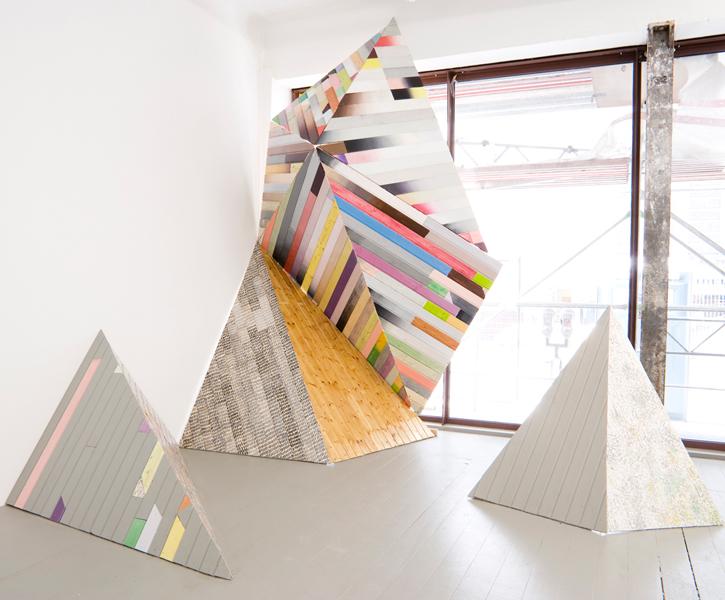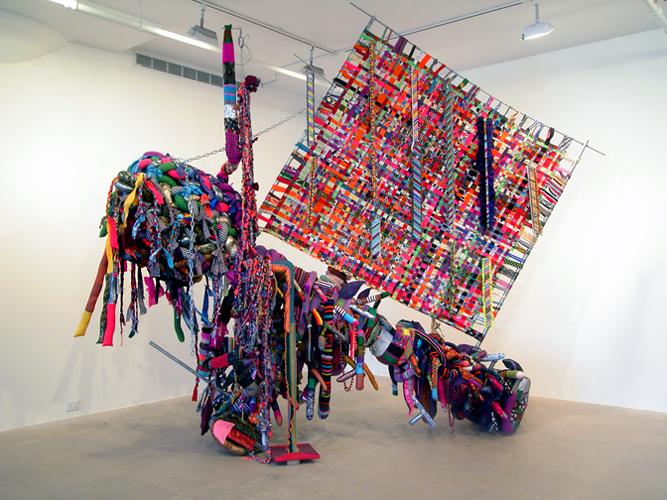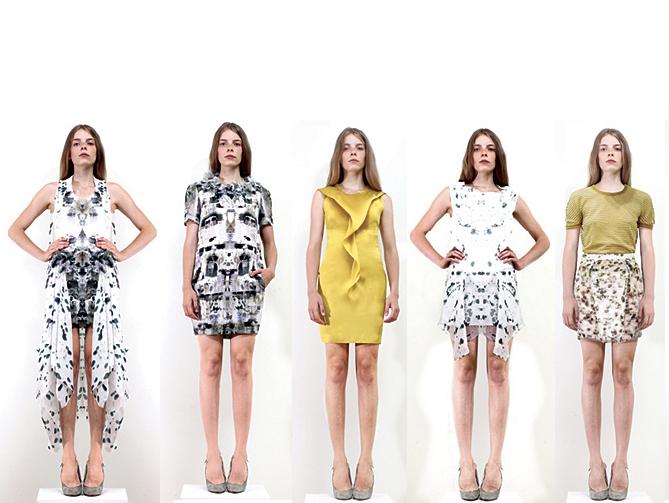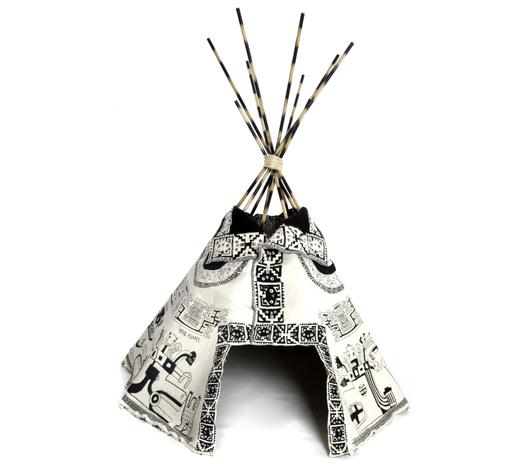
06.23.11
Q+A
Irene Alvarez, Artist
Antwerp’s Irene Alvarez was a sculptor and recent Royal Academy art grad when she got the call from the cult concept shop Ra — the city’s version of Opening Ceremony — asking her to design a custom installation. But it was the far less glamorous moment that came next that has since marked a pivotal moment in her nascent career: She discovered the Netherlands’ Textile Museum Tilburg, which is not only a museum but also an experimental production lab where creatives can apply for technical assistance on machines capable of knitting, embroidering, lasering, printing, tufting, dyeing, and weaving almost anything the mind can conceive. Despite having no previous experience with textiles, she collaborated with the museum on the half-woven Inti Altar sculpture that’s held court on Ra’s second floor for the last two years, and she’s been addicted to the furry medium ever since. Today marks the opening of her first solo show, at Belgium’s other hallowed retail emporium, Hunting and Collecting, and it demonstrates just how far Alvarez has come in her obsession with knits — it contains no traditional sculpture at all, only a textile teepee (above), a line of t-shirts, and a series of three tapestries woven with a psychedelic clash of pop-culture icons and op-art patterning. Sight Unseen recently spoke with the artist about her work with the museum and the ethnic influences behind her imagery.
You never worked with textiles before you created the installation for Ra. How did you get so interested in the medium?
“A lot of people here in Antwerp go to the textile museum in Tilburg to having weavings produced — I saw one of my friends making something this way for her fashion collection. Since I had this commission for Ra, a fashion store, I thought why not do something related to fashion? So even though I had no previous experience with textiles I decided to turn one of my illustrations into a carpet. Once I took my ideas to the museum, I started getting the hang of it, and wanted to do more. Making my drawings into textiles gives them a whole new feeling — they become more like objects. I’m really interested in industrial design and the making of objects.”
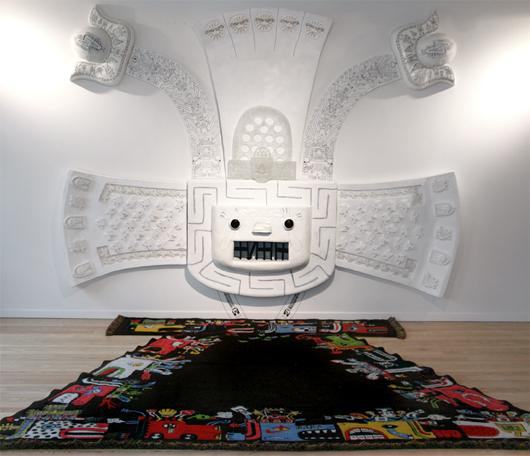
The artist’s half-sculpted, half-woven Inti Altar installation at Ra in Antwerp
What’s the process of working with the textile museum like, and how hands-on is it? Do you ever get to touch the weaving tools yourself?
“You go there with your drawing and they sit you down and guide you a bit, showing you yarns and fabric samples from past projects by other designers, so it’s just about trying different approaches until you find the one that works for your piece. Maybe I’d take a mohair and an acrylic and it would come out too furry, then maybe I would try with plastic yarns or different colors and textures: shiny, hairy, metallic. The technician feeds your Illustrator file into the computer through this textile pixel program and then sends it to the weaving machine, and once the first 8 to 12 inches comes out you stop to check how it’s going. If you don’t like the first sample, you go back to the computer and make changes until the technician sends it through again. For me the most important thing was staying true to the drawing, so I would mix various yarns and techniques and keep trying until it looked exactly like the image I had in my head.”
Where did the idea for the new Turn Me Op pieces come from?
“I got really into seeing textiles as a series of pixels, and everything became really optical for me, so that led into doing something that mixed op-art with street art and pop culture, themes that recur in the rest of my work. The Turn Me Op textiles are woven with psychedelic and pop imagery, and they have visual effects that make you a bit dizzy. What I’m really doing is making tapestries — which are meant to reflect the way a given society lives, its culture — and giving them a contemporary twist.”
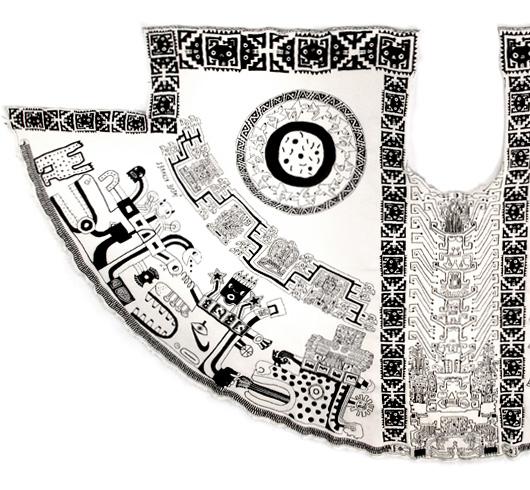
Detail from the textile used for Alvarez’s new teepee
If you look closely at the Ra installation and the other work on view at Hunting and Collecting, you can see some of those contemporary references hidden within seemingly tribal patterns. Can you give some examples?
“I’m really inspired by ethnic art, work by the Incas, the Aztecs, the Mayans. Even the indigenous art from Africa or New Zealand. The drawings on the teepee, for example, reference a book of ancient Incan art that I have. But within there is a cow, a shoe with a Nike sign below its eye, and a series of computer chips that follow a specific motif I found in the book. It’s all about digital and consumer culture. The t-shirts, which are a collaboration with an Australian designer whose line is called A Label By, are inspired by the forms and patterns of Peruvian textiles. They’re silkscreened, but they appear to have the same pixellation as woven fabric. One features a green and pink skull with long teeth; there’s another that looks like the head and front legs of a jaguar, and then the back of the shirt has the tail and the back legs, so it’s kind of like wearing a skin. The one that looks like E.T. is supposed to be like a necklace. So I was just making drawings and trying to fit them onto the shirts in a way that resembled accessories.”
Does living and working in Antwerp make interacting with the fashion world seem somehow unavoidable?
“Well there’s just so much fashion here, and so many people doing fashion-related things, so especially if you start to work with textile art, it’s easy to find yourself in that context. But what I’m doing isn’t really fashion in the end.”
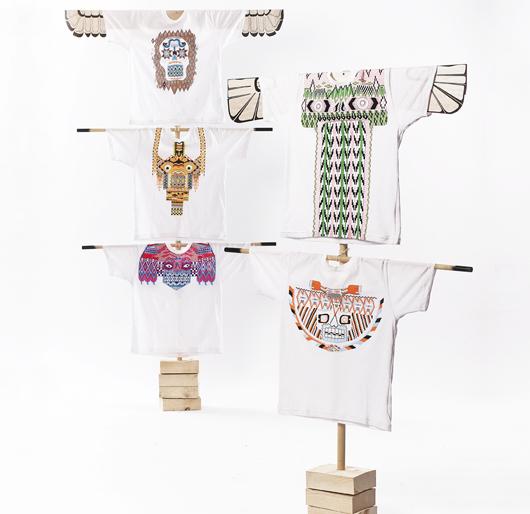
Alvarez’s screenprinted Totem T-shirts, now on sale at Hunting and Collecting
